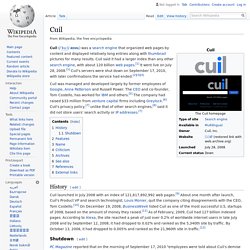

The Rebuilt Antikythera Solves Secrets Of The World’s First Computer. The famous ancient Greek astronomical calculator known as the “Antikythera Mechanism” is a mechanical device created to predict astronomical events.

Now, UCL scientists have recreated the tool which is known as the oldest analogue computational machine ever discovered. At 2000 years, it is “still” the oldest analog computational machine ever discovered. Now, University College London (UCL) scientists have created a “theoretical” rebuilt Antikythera device that solves the mysteries and problems in amazing ways. 2,000 Year Old Computer - Decoding the Antikythera Mechanism - Full Documentary HD. Revolutions: The Ideas that Changed the World - The Smartphone.
Heath Robinson. Development of the Heath Robinson started in January 1943 and the first prototype was delivered at Bletchley Park in June 1943.

It was put to work soon afterwards. Robinson. ENIAC simulation: simulation. Running the simulation documentation.

How the ZX Spectrum helped bring about famed pop parody Frank Sidebottom. Walk down any British high street in the 1980s, and you’d be bombarded by an array of computers for sale.

The Commodore 64, Dragon 32 and Acorn Electron formed a wave of microcomputers, so-called for their small size and cost. The best remembered of all the “micros” arguably came from Cambridge based company Sinclair Research Ltd. Their ZX81 was a silent, black-and-white machine. Just £70 when launched in 1981, 1.5m were sold, despite their meagre 1KB of default memory. Which Of These Internet Pioneers Was Pivotal In Creating A Decentralized, Communication-Centered Internet? Answer: Robert Taylor Today it seems like an absolutely elementary concept: geographically distant computer networks are the most useful when they are all connected.

Google Doodles. Computer history museum, mountain view, california. Cuil - Wikipedia. Cuil (/ˈkuːl/ KOOL) was a search engine that organized web pages by content and displayed relatively long entries along with thumbnail pictures for many results.

Cuil said it had a larger index than any other search engine, with about 120 billion web pages.[1] It went live on July 28, 2008.[1] Cuil's servers were shut down on September 17, 2010, with later confirmations the service had ended.[2][3][4] Cuil was managed and developed largely by former employees of Google, Anna Patterson and Russell Power. The CEO and co-founder, Tom Costello, has worked for IBM and others.[5] The company had raised $33 million from venture capital firms including Greylock.[6] Cuil's privacy policy,[7] unlike that of other search engines,[8] said it did not store users’ search activity or IP addresses.[7] History[edit] Shutdown[edit] PC Magazine reported that on the morning of September 17, 2010 "employees were told about Cuil's demise [...] and the servers were taken offline five hours later Features[edit]
Moore's Law. Her Code Got Humans on the Moon—And Invented Software Itself. Margaret Hamilton wasn’t supposed to invent the modern concept of software and land men on the moon.

It was 1960, not a time when women were encouraged to seek out high-powered technical work. Hamilton, a 24-year-old with an undergrad degree in mathematics, had gotten a job as a programmer at MIT, and the plan was for her to support her husband through his three-year stint at Harvard Law. After that, it would be her turn—she wanted a graduate degree in math. But the Apollo space program came along.
And Hamilton stayed in the lab to lead an epic feat of engineering that would help change the future of what was humanly—and digitally—possible. As a working mother in the 1960s, Hamilton was unusual; but as a spaceship programmer, Hamilton was positively radical. “People used to say to me, ‘How can you leave your daughter? The Birth of the Internet. The Birth and Development of the ARPANET. IBM and the Holocaust - Home Page. Home to The First Electronic Computers. Jeremy Clarkson - Inventions That Changed the World - Computer (Rus sub)
Ada Lovelace Day. Who was Ada Lovelace?

By Sydney Padua, author of The Thrilling Adventures of Lovelace & Babbage. Read the longer biography of Ada Lovelace by Suw Charman-Anderson, taken from our book, A Passion for Science: Stories of Discovery and Invention, but for a short overview of her life and achievements, read on! The woman most often known as ‘Ada Lovelace’ was born Ada Gordon in 1815, sole child of the brief and tempestuous marriage of the erratic poet George Gordon, Lord Byron, and his mathematics-loving wife Annabella Milbanke.
Fearing that Ada would inherit her father’s volatile ‘poetic’ temperament, her mother raised her under a strict regimen of science, logic, and mathematics. The Babbage Engine. BBC Mechanical Marvels Clockwork Dreams. Jacquard loom. This portrait of Jacquard was woven in silk on a Jacquard loom and required 24,000 punched cards to create (1839).

It was only produced to order. Charles Babbage owned one of these portraits; it inspired him in using perforated cards in his analytical engine.[1] It is in the collection of the Science Museum in London, England.[2] Computer History. John Kopplin © 2002 Just a few years after Pascal, the German Gottfried Wilhelm Leibniz (co-inventor with Newton of calculus) managed to build a four-function (addition, subtraction, multiplication, and division) calculator that he called the stepped reckoner because, instead of gears, it employed fluted drums having ten flutes arranged around their circumference in a stair-step fashion.

Although the stepped reckoner employed the decimal number system (each drum had 10 flutes), Leibniz was the first to advocate use of the binary number system which is fundamental to the operation of modern computers. Leibniz is considered one of the greatest of the philosophers but he died poor and alone. Leibniz's Stepped Reckoner (have you ever heard "calculating" referred to as "reckoning"?) World’s First Computer Rebuilt, Rebooted After 2,000 Years.
A British museum curator has built a working replica of a 2,000-year-old Greek machine that has been called the world’s first computer. A dictionary-size assemblage of 37 interlocking dials crafted with the precision and complexity of a 19th-century Swiss clock, the Antikythera mechanism was used for modeling and predicting the movements of the heavenly bodies as well as the dates and locations of upcoming Olympic games.
The original 81 shards of the Antikythera were recovered from under the sea (near the Greek island of Antikythera) in 1902, rusted and clumped together in a nearly indecipherable mass. Scientists dated it to 150 B.C. Such craftsmanship wouldn’t be seen for another 1,000 years — but its purpose was a mystery for decades.